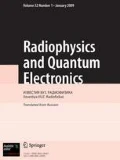We propose a method for considering the spread of initial electron velocities caused by the roughness of the cathode surface while performing a three-dimensional trajectory analysis in the gyrotron electron–optical system. The effect of the size of roughness on the velocity characteristics of the electron beam entering the gyrotron cavity with a frequency of 74.2 GHz and an output power of approximately 100 kW was determined in the simulations. Comparison of simulation data with experimental results showed that the average size of cathode inhomogeneities for this gyrotron is approximately 14 μm for the model of a cathode with regular hemispheres on its surface.
Similar content being viewed by others
References
A.G.Litvak, G.G.Denisov, V. E.Myasnikov, et al., J. Infrared Millim. Terahertz Waves, 32, No. 3, 337–342 (2011). https://doi.org/10.1007/s10762-010-9743-8
M. Thumm, J. Infrared Millim. Terahertz Waves, 41, No. 1, 1–140 (2020). https://doi.org/10.1007/s10762-019-00631-y
G. S.Nusinovich, Introduction to Physics of Gyrotons, Johns Hopkins Univ. Press, Baltimore (2004).
A. L. Gol’denberg and M. I.Petelin, Radiophys. Quantum Electron., 16, No. 1, 106–111 (1973). https://doi.org/10.1007/BF01080801
Sh. E.Tsimring, Radiophys. Quantum Electron., 15, No. 8, 952–961 (1972). https://doi.org/10.1007/BF01030951
Sh. E.Tsimring, Electron Beams and Microwave Vacuum Electronics, John Wiley & Sons, Hoboken (2007).
M.Yu.Glyavin, A.N.Kuftin, N.P.Venediktov, et al., Int. J. Infrared Millim. Waves, 18, No. 11, 2137–2146 (1997). https://doi.org/10.1007/BF02678256
R. L. Ives, P.Borchard, G. Collins, et al., IEEE Trans. Plasma Sci., 36, No. 3, 620–630 (2008). https://doi.org/10.1109/TPS.2008.917529
O. I. Louksha, B. Piosczyk, G. G. Sominski, et al., IEEE Trans. Plasma Sci., 34, No. 3, 502–511 (2006). https://doi.org/10.1109/TPS.2006.875779
J. Zhang, S. Illy, I.Gr.Pagonakis, et al., IEEE Trans. Electron Dev., 64, No. 3, 1315–1322 (2017). https://doi.org/10.1109/TED.2017.2655147
O. I. Louksha and P. A.Trofimov, Tech. Phys., 63, No. 4, 598–604 (2018). https://doi.org/10.1134/S106378421804014X
K. A. Leshcheva and V. N. Manuilov, Usp. Prikl. Fiz ., 7, No. 3, 298–308 (2019).
O. I. Louksha, B. Piosczyk, G. G. Sominski, et al., Radiophys. Quantum Electron., 49, No. 10, 793–798 (2006). https://doi.org/10.1007/s11141-006-0114-1
E. G.Avdoshin, L.V.Nikolaev, I. N. Platonov, and Sh. E.Tsimring, Radiophys. Quantum Electron., 16, No. 4, 461–466 (1973). https://doi.org/10.1007/BF01030896
Y. Y. Lau, J. Appl. Phys., 61, No. 1, 36–44 (1987). https://doi.org/10.1063/1.338833
V. K. Lygin, Int. J. Infrared Millim. Waves, 16, No. 2, 363–376 (1995). https://doi.org/10.1007/BF02096323
V. E. Zapevalov, S.Yu.Kornishin, A.V.Kotov, et al., Radiophys. Quantum Electron., 53, No. 4, 229–236 (2010). https://doi.org/10.1007/s11141-010-9221-0
J. Zhang, S. Illy, I.Gr.Pagonakis, et al., Nucl. Fusion, 56, No. 2, 026002 (2016). https://doi.org/10.1088/0029-5515/56/2/026002
https://www.3ds.com/products-services/simulia/products/cst-studio-suite/
D. V. Kas’yanenko, O. I. Louksha, B. Piosczyk, et al., Radiophys. Quantum Electron., 47, Nos. 5–6, 414–420 (2004). https://doi.org/10.1023/B:RAQE.0000046315.10190.1c
O. I. Louksha, G. G. Sominski, A.V.Arkhipov, et al., IEEE Trans. Plasma Sci., 44, No. 8, 1310–1319 (2016). https://doi.org/10.1109/TPS.2016.2590143
O. I. Louksha, D. B. Samsonov, G.G. Sominskii, and S.V. Semin, Tech. Phys., 58, No. 5, 751–759 (2013). https://doi.org/10.1134/S1063784213050137
A. L. Gol’denberg, V.K. Lygin, V.N.Manuilov, et al., in: A.V.Gaponov-Grekhov, ed., The Gyrotron (collected papers) [in Russian], Institute of Applied Physics of the USSR Academy of Scienses, Gorky (1981).
O. I. Louksha and P. A.Trofimov, Tech. Phys., 64, No. 12, 1889–1897 (2019). https://doi.org/10.1134/S1063784219120156
O. I. Luksha, Radiophys. Quantum Electron., 52, Nos. 5–6, 386–397 (2009). https://doi.org/10.1007/s11141-009-9149-4
O. I. Louksha, D. B. Samsonov, G.G. Sominskii, and A.A.Tsapov, Tech. Phys., 57, No. 6, 835–839 (2012). https://doi.org/10.1134/S1063784212060187
Author information
Authors and Affiliations
Corresponding author
Additional information
Translated from Izvestiya Vysshikh Uchebnykh Zavedenii, Radiofizika, Vol. 65, No. 3, pp. 226–237, March 2022. Russian DOI:https://doi.org/10.52452/00213462_2022_65_03_226
Rights and permissions
Springer Nature or its licensor (e.g. a society or other partner) holds exclusive rights to this article under a publishing agreement with the author(s) or other rightsholder(s); author self-archiving of the accepted manuscript version of this article is solely governed by the terms of such publishing agreement and applicable law.
About this article
Cite this article
Louksha, O.I., Trofimov, P.A. & Malkin, A.G. Trajectory Analysis in a Gyrotron Electron–Optical System with Allowance for the Cathode Surface Roughness. Radiophys Quantum El 65, 209–218 (2022). https://doi.org/10.1007/s11141-023-10206-6
Received:
Accepted:
Published:
Issue Date:
DOI: https://doi.org/10.1007/s11141-023-10206-6


